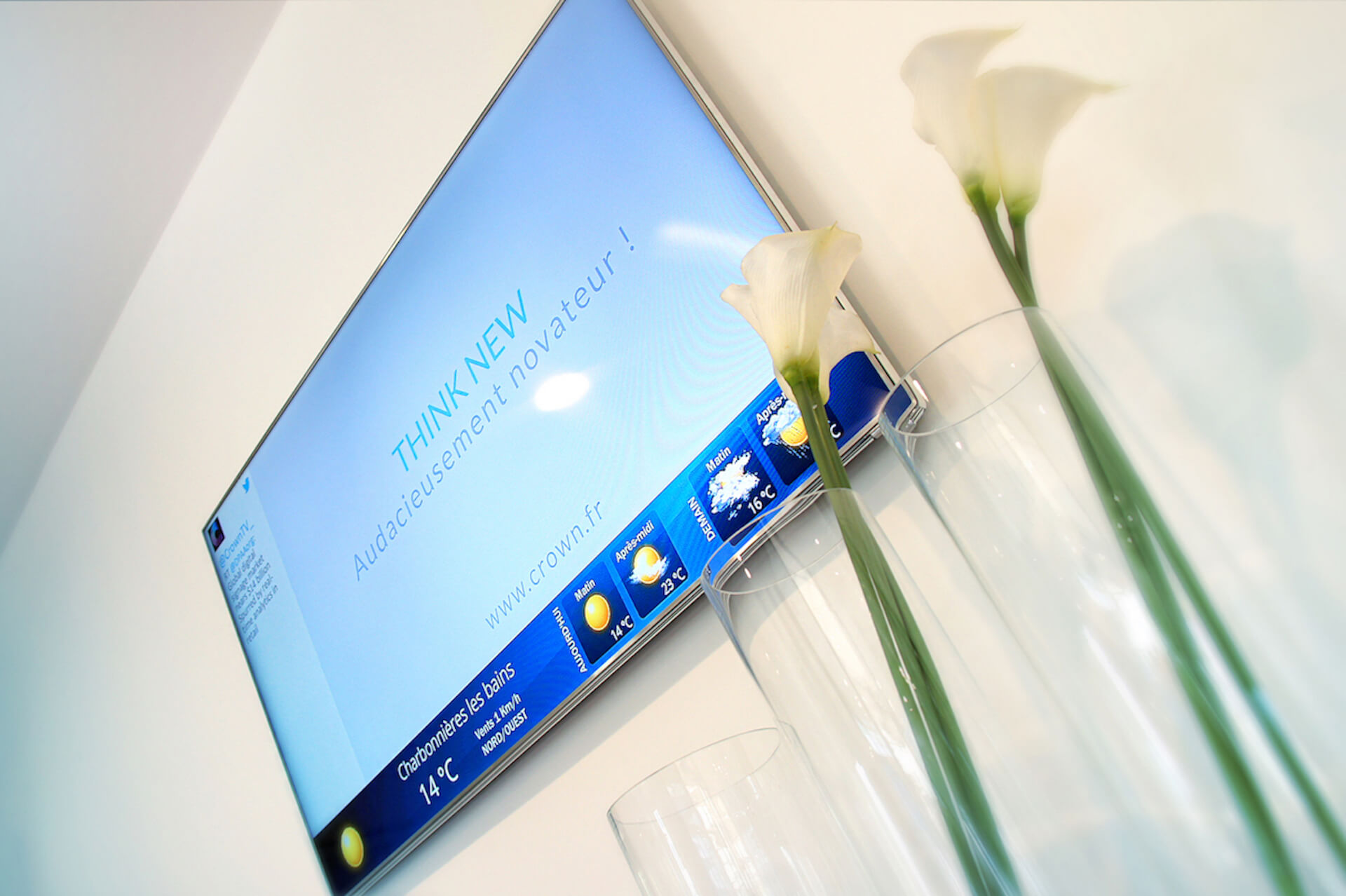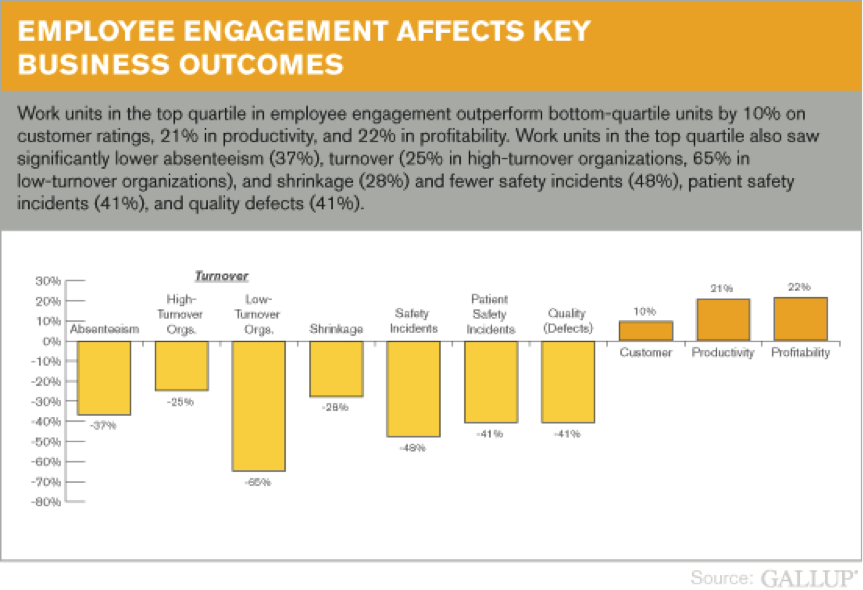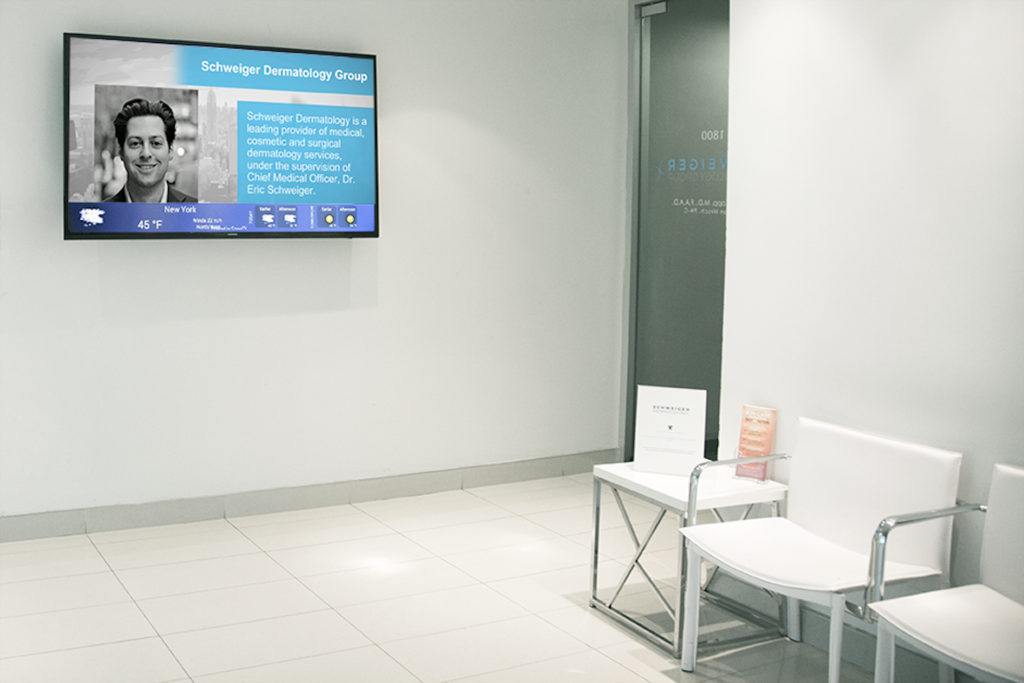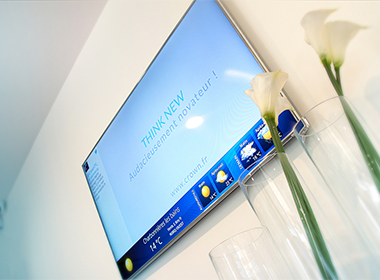The American workplace has changed dramatically over the past few decades. Or, as they say in the tech industry, it’s been “disrupted”. Open layouts have replaced cubicles, company cultures have become more horizontal, office technologies have advanced and it isn’t unusual to see a ping pong table next to the kitchen. Shifting attitudes, especially among startups, towards work-life balance and company culture are largely to thank. Thank them we should, for many of these shifts are bringing positive changes to the way we do business.
Many of these changes involve a heavier focus on internal communications, employee engagement and internal marketing. Workplace digital signage helps businesses tackle each of these disciplines while connecting and sprucing up their offices. Here are four reasons workplace digital signage is a must for the modern office.
1. Internal communications is changing
Internal communications as a business practice dates back to the late 19th century, with the first company magazine appearing between 1840-45. In the twentieth century it has become an increasingly sophisticated effort, with certification programs and job titles like “Internal Communications Manager” or “Corporate Communications Director” popping up. Technology has played a huge role, with tools like Slack and HipChat for team chat and enterprise social networking rising in popularity (Slack surpassed one million active users a day in 2015).
Generational shifts have also played a role. “Millennials and all following generations are more demanding than ever, especially concerning the ways their employer is talking and listening to them. They expect less politics, more collaboration, high transparency and regular feedback,” says Staffbase.
Internal communications are changing in purpose as well as importance, with more employees wanting to know “what’s in it for me?”. Expert David Grossman explains:
“Employees don’t need to know everything, but they do need to know the “WHAT” and the “WHY.” What are we doing, and why are we doing it? Without this overarching context, your team lacks the information to work with purpose and direction. Then, your team needs to know how it affects them, what’s in it for them, and its relevance.”
How can the modern office adapt to these changes? Adding workplace digital signage is a start, addressing both the issues of importance and purpose.

Digital displays placed throughout an office make internal communications omnipresent, telling your team it’s a priority. Employees will be constantly reminded of the messages as well as their importance. A variety of content can be displayed, from sales goals to social media feeds, keeping your internal communications fresh, dynamic and all-encompassing.
Digital signage messaging addresses the what and why Grossman refers to. The what can be made as specific and thorough as necessary through the use of text, live metrics, scheduling, graphics and video. The why can be iterated by stating the goals, purpose, expected outcomes and rewards for employees’ hard work. Quality digital signage software, like CrownTV’s, makes all messages highly customizable and easy to edit as needed, so you can craft them however you wish in order to get the right message across. You can even create different content for multiple locations to localize and pinpoint your messages.
2. Employee engagement is more necessary than ever
Google Trends is a tool launched in 2006 that reveals how many times a term has been searched for in Google since 2004. It’s an interesting and simple way to measure interest in any given topic over time. For our purposes, it provides valuable insight into workplace and company culture trends.
When looking at the term “employee engagement” in Google Trends, we see a huge increase in searches worldwide since 2004:
As of February 2016, the term has seen a ten-fold increase in searches since February 2004. That’s huge, especially considering that the terms “internal communications” and “company culture” have actually fallen in search volume over the same time frame.
There are two main reasons employee engagement has become such a large focus: 1) it’s been shown to increase productivity, and 2) most employees are not feeling engaged at work.
Gallup’s 2013 State of the American Workplace report found that high levels of employee engagement affect key business outcomes. Work units ranked in the top quartile for employee engagement saw the following when compared to bottom-quartile units:
- 10% higher customer ratings
- 22% more profitability
- 21% more productivity
- Lower turnover (25% less in high-turnover organizations, 65% less in low-turnover organizations)
- 37% less absenteeism

With these numbers in mind, managers are eager to get their employees engaged – but many of them aren’t succeeding. The Gallup report also revealed that only 30% of U.S. employees are engaged in their work, “meaning that the vast majority of U.S. workers (70%) are not reaching their full potential — a problem that has significant implications for the economy and the individual performance of American companies.”
Fortunately, there is a remedy in workplace digital signage. We already know digital signage engages consumers, but employees are consumers too – of your brand and company culture. Workplace digital signage engages employees by displaying a wide range of content in many different forms (text, numbers, graphics, etc.) and creating a two-way experience.
Display interactive content like live metrics, social media feeds, daily trivia and local weather to keep things fresh and exciting. Encourage employees to get in on the experience, contributing to what’s on the screen and posting their own messages via social media. Make them feel appreciated by giving shoutouts to teams or individuals for their achievements, or wish someone a happy birthday. Keep everyone aligned with the company’s culture and mission through the messages you display.
3. Internal marketing is important too
Along with the rise of internal communications has come the rise of internal marketing – when businesses market their company and its brand, products, goals, policies, beliefs, messaging, etc. from within to their employees. Think of it as marketing from the inside out, with employees being treated as though they are the company’s internal consumers.
“In recent years, the idea of internal marketing has grown in clout and necessity, incorporating a company’s employees in an all-hands-in marketing approach.” –Connote Magazine
Internal marketing has the potential to turn employees into brand ambassadors for your company, which is a powerful tool for growth. When you’re constantly marketing your company to employees internally, they will eventually want to spread the word externally. It has far-reaching benefits that will help your overall marketing and sales efforts.
We know digital signage is an effective marketing tool, and that applies both internally and externally. It’s highly customizable and easy to incorporate branding into your content, allowing you to align your external branding and messaging with your internal marketing efforts.

Using CrownTV’s custom-branded templates, companies can have all of their digital signage content include their logo, color scheme and any proprietary images, animations or videos. The image above is a great example of Schweiger Dermatology Group, a CrownTV client, practicing internal marketing through workplace digital signage. Schweiger, a leading dermatology practice with locations throughout New York and New Jersey, uses our custom-branded templates to highlight their services and doctors on staff.
Other ways to use workplace digital signage for internal marketing include:
- Prompting employees to follow company social media channels, and join the conversation by using branded hashtags
- Displaying interesting trivia about the company
- Sharing industry news and insights
- Circulating company updates like new product releases, media coverage or milestones reached
When your internal communications efforts can double as internal marketing tools, your workplace digital signage kills two birds with one stone.
4. Workplaces are becoming “smarter” and more connected
Modern workplaces look nothing like they did twenty or even ten years ago in terms of layout, aesthetics and functionality. Many workplaces have embraced the open office layout, where walls are quite literally knocked down in effort to foster collaboration and a more horizontal company culture. Office design has become more architecturally unique, colorful and branded yet clean. Startups in particular are creating fun, edgy workplaces by including basketball hoops, ping pong tables, funky furniture and extravagant lounge areas.
Another crucial component of modern office design is connectivity and technology. As with “employee engagement”, Google Trends also shows an increase in searches for “connected office” since 2004:
Workplaces want to be connected and up-to-date with the latest technology, but they also want to appear connected. Having nice computers, large flat-screen TVs, and tablets for check-in at reception are a few ways to do so, but workplace digital signage will really set your office apart both aesthetically and functionally.
Digital displays add a modern look and feel to any workplace, and their crisp, vibrant visuals are much more pleasing to the eye than traditional signage. Functionally, they keep your office and employees connected through internal communications, and with the outside world through live content like social media, news and weather feeds. Anyone who visits your office – employee or not – will remember it as being tech-savvy, contemporary and cutting-edge.
Conclusion
Workplace digital signage is a single tool that addresses multiple pain points: communication, engagement, marketing and connectivity, to name just a few. Not to mention, it’s attractive and memorable. The needs and priorities of workplaces will continue to change, but digital signage will adapt along with it.
CrownTV’s constantly evolving technology ensures you’ll never be left behind, and is highly customizable to your team, locations and goals. Request a demo of our solution today.

